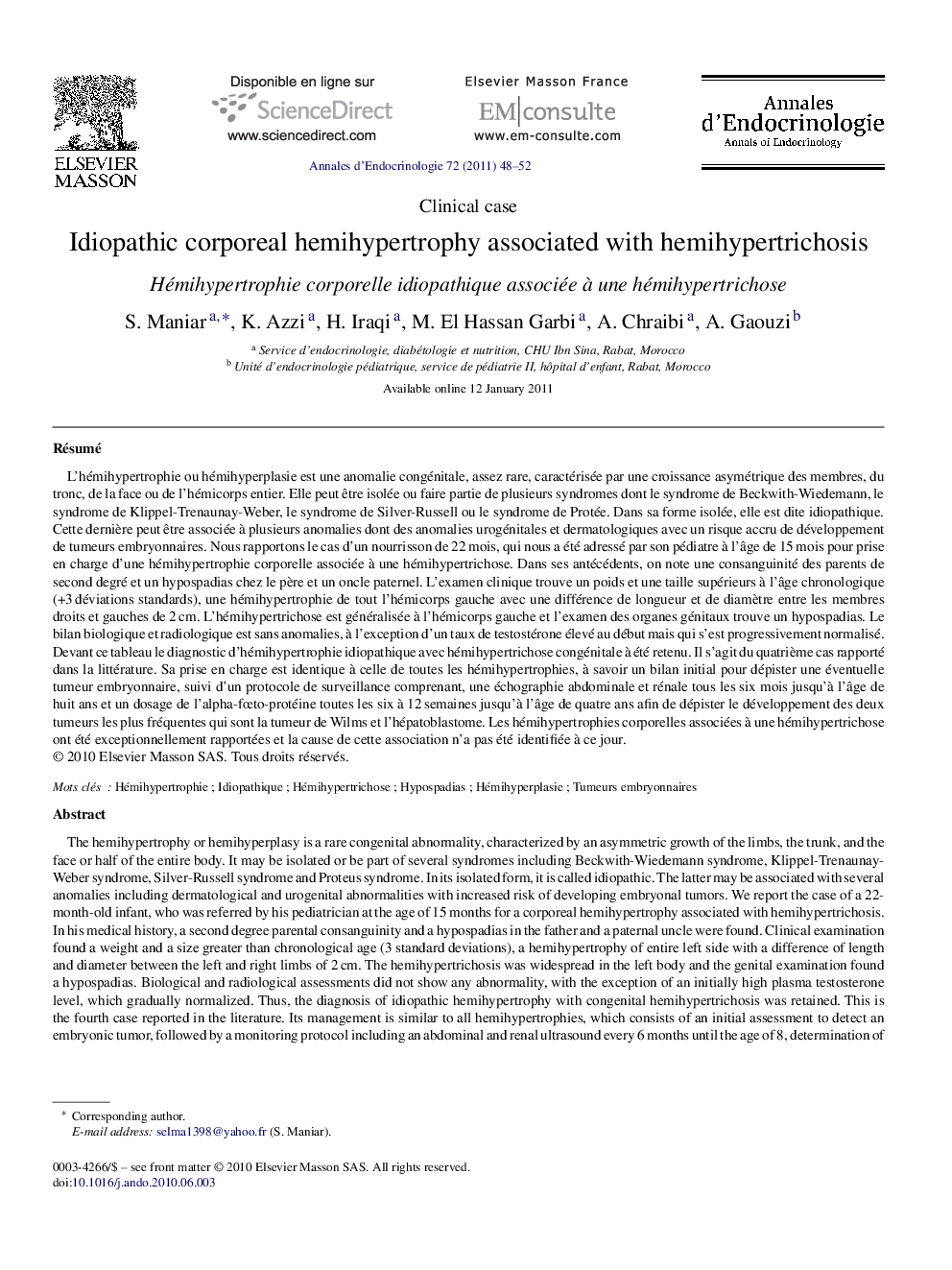| Article ID | Journal | Published Year | Pages | File Type |
|---|---|---|---|---|
| 3252608 | Annales d'Endocrinologie | 2011 | 5 Pages |
RésuméL’hémihypertrophie ou hémihyperplasie est une anomalie congénitale, assez rare, caractérisée par une croissance asymétrique des membres, du tronc, de la face ou de l’hémicorps entier. Elle peut être isolée ou faire partie de plusieurs syndromes dont le syndrome de Beckwith-Wiedemann, le syndrome de Klippel-Trenaunay-Weber, le syndrome de Silver-Russell ou le syndrome de Protée. Dans sa forme isolée, elle est dite idiopathique. Cette dernière peut être associée à plusieurs anomalies dont des anomalies urogénitales et dermatologiques avec un risque accru de développement de tumeurs embryonnaires. Nous rapportons le cas d’un nourrisson de 22 mois, qui nous a été adressé par son pédiatre à l’âge de 15 mois pour prise en charge d’une hémihypertrophie corporelle associée à une hémihypertrichose. Dans ses antécédents, on note une consanguinité des parents de second degré et un hypospadias chez le père et un oncle paternel. L’examen clinique trouve un poids et une taille supérieurs à l’âge chronologique (+3 déviations standards), une hémihypertrophie de tout l’hémicorps gauche avec une différence de longueur et de diamètre entre les membres droits et gauches de 2 cm. L’hémihypertrichose est généralisée à l’hémicorps gauche et l’examen des organes génitaux trouve un hypospadias. Le bilan biologique et radiologique est sans anomalies, à l’exception d’un taux de testostérone élevé au début mais qui s’est progressivement normalisé. Devant ce tableau le diagnostic d’hémihypertrophie idiopathique avec hémihypertrichose congénitale à été retenu. Il s’agit du quatrième cas rapporté dans la littérature. Sa prise en charge est identique à celle de toutes les hémihypertrophies, à savoir un bilan initial pour dépister une éventuelle tumeur embryonnaire, suivi d’un protocole de surveillance comprenant, une échographie abdominale et rénale tous les six mois jusqu’à l’âge de huit ans et un dosage de l’alpha-fœto-protéine toutes les six à 12 semaines jusqu’à l’âge de quatre ans afin de dépister le développement des deux tumeurs les plus fréquentes qui sont la tumeur de Wilms et l’hépatoblastome. Les hémihypertrophies corporelles associées à une hémihypertrichose ont été exceptionnellement rapportées et la cause de cette association n’a pas été identifiée à ce jour.
The hemihypertrophy or hemihyperplasy is a rare congenital abnormality, characterized by an asymmetric growth of the limbs, the trunk, and the face or half of the entire body. It may be isolated or be part of several syndromes including Beckwith-Wiedemann syndrome, Klippel-Trenaunay-Weber syndrome, Silver-Russell syndrome and Proteus syndrome. In its isolated form, it is called idiopathic. The latter may be associated with several anomalies including dermatological and urogenital abnormalities with increased risk of developing embryonal tumors. We report the case of a 22-month-old infant, who was referred by his pediatrician at the age of 15 months for a corporeal hemihypertrophy associated with hemihypertrichosis. In his medical history, a second degree parental consanguinity and a hypospadias in the father and a paternal uncle were found. Clinical examination found a weight and a size greater than chronological age (3 standard deviations), a hemihypertrophy of entire left side with a difference of length and diameter between the left and right limbs of 2 cm. The hemihypertrichosis was widespread in the left body and the genital examination found a hypospadias. Biological and radiological assessments did not show any abnormality, with the exception of an initially high plasma testosterone level, which gradually normalized. Thus, the diagnosis of idiopathic hemihypertrophy with congenital hemihypertrichosis was retained. This is the fourth case reported in the literature. Its management is similar to all hemihypertrophies, which consists of an initial assessment to detect an embryonic tumor, followed by a monitoring protocol including an abdominal and renal ultrasound every 6 months until the age of 8, determination of alpha-feto-protein every 6 to 12 weeks until the age of 4 years to track the development of the two most frequent tumors: Wilms tumor and hepatoblastoma. The hemihypertrophy associated with hemihypertrichosis has been exceptionally reported and the cause of this association has not been identified to date.
